Microsoft 70-467 Exam Practice Questions (P. 3)
- Full Access (102 questions)
- Six months of Premium Access
- Access to one million comments
- Seamless ChatGPT Integration
- Ability to download PDF files
- Anki Flashcard files for revision
- No Captcha & No AdSense
- Advanced Exam Configuration
Question #11
DRAG DROP -
You are designing a SQL Server Integration Services (SSIS) package to execute 12 Transact-SQL (T-SQL) statements on a SQL Azure database.
The T-SQL statements may be executed in any order. The T-SQL statements have unpredictable execution times.
You have the following requirements:
The package must maximize parallel processing of the T-SQL statements.
After all the T-SQL statements have completed, a Send Mail task must notify administrators.
You need to design the SSIS package.
Which three actions should you perform in sequence? (To answer, move the appropriate actions from the list of actions to the answer area and arrange them in the correct order.)
Select and Place:
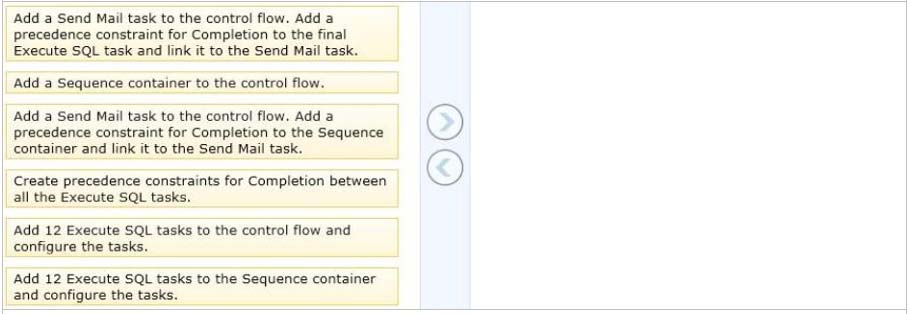
You are designing a SQL Server Integration Services (SSIS) package to execute 12 Transact-SQL (T-SQL) statements on a SQL Azure database.
The T-SQL statements may be executed in any order. The T-SQL statements have unpredictable execution times.
You have the following requirements:
The package must maximize parallel processing of the T-SQL statements.
After all the T-SQL statements have completed, a Send Mail task must notify administrators.
You need to design the SSIS package.
Which three actions should you perform in sequence? (To answer, move the appropriate actions from the list of actions to the answer area and arrange them in the correct order.)
Select and Place:

Correct Answer:
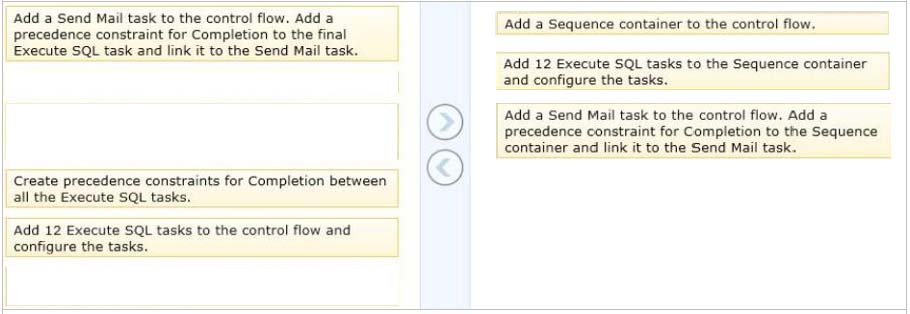
Note:
The Sequence container defines a control flow that is a subset of the package control flow. Sequence containers group the package into multiple separate control flows, each containing one or more tasks and containers that run within the overall package control flow.
Reference: Sequence Container

Note:
The Sequence container defines a control flow that is a subset of the package control flow. Sequence containers group the package into multiple separate control flows, each containing one or more tasks and containers that run within the overall package control flow.
Reference: Sequence Container
send
light_mode
delete
Question #12
HOTSPOT -
You are configuring the partition storage settings for a SQL Server Analysis Services (SSAS) cube.
The partition storage must meet the following requirements:
✑ Optimize the storage of source data and aggregations in the cube.
✑ Use proactive caching.
✑ Drop cached data that is more than 30 minutes old.
Update the cache when data changes, with a silence interval of 10 seconds.

You need to select the partition storage setting.
Which setting should you select?
To answer, select the appropriate setting in the answer area.
Hot Area:
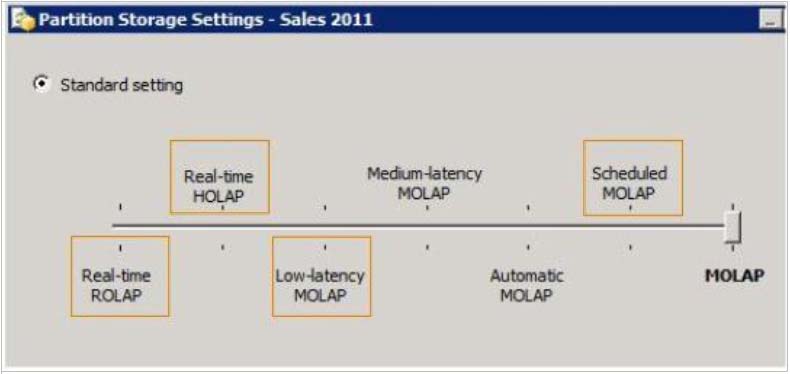
You are configuring the partition storage settings for a SQL Server Analysis Services (SSAS) cube.
The partition storage must meet the following requirements:
✑ Optimize the storage of source data and aggregations in the cube.
✑ Use proactive caching.
✑ Drop cached data that is more than 30 minutes old.
Update the cache when data changes, with a silence interval of 10 seconds.

You need to select the partition storage setting.
Which setting should you select?
To answer, select the appropriate setting in the answer area.
Hot Area:

Correct Answer:
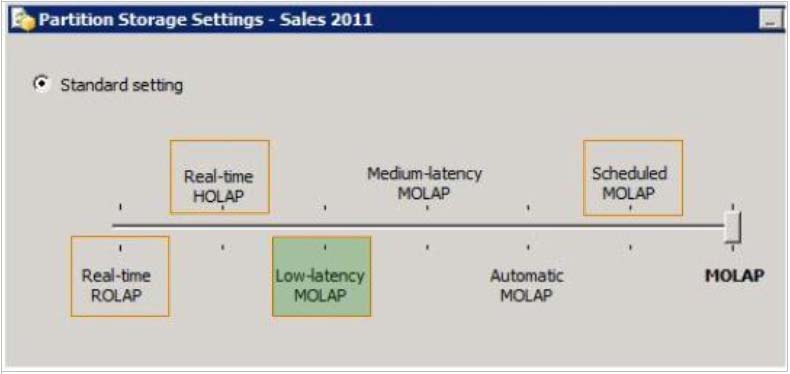
http://msdn.microsoft.com/en-us/library/ms175646.aspx
Low Latency MOLAP -
Detail data and aggregations are stored in multidimensional format. The server listens for notifications of changes to the data and switches to real-time ROLAP while MOLAP objects are reprocessed in a cache. A silence interval of at least 10 seconds is required before updating the cache. There is an override interval of
10 minutes if the silence interval is not attained. Processing occurs automatically as data changes with a target latency of 30 minutes after the first change.
This setting would typically be used for a data source with frequent updates when query performance is somewhat more important than always providing the most current data. This setting automatically processes MOLAP objects whenever required after the latency interval. Performance is slower while the MOLAP objects are being reprocessed.

http://msdn.microsoft.com/en-us/library/ms175646.aspx
Low Latency MOLAP -
Detail data and aggregations are stored in multidimensional format. The server listens for notifications of changes to the data and switches to real-time ROLAP while MOLAP objects are reprocessed in a cache. A silence interval of at least 10 seconds is required before updating the cache. There is an override interval of
10 minutes if the silence interval is not attained. Processing occurs automatically as data changes with a target latency of 30 minutes after the first change.
This setting would typically be used for a data source with frequent updates when query performance is somewhat more important than always providing the most current data. This setting automatically processes MOLAP objects whenever required after the latency interval. Performance is slower while the MOLAP objects are being reprocessed.
send
light_mode
delete
Question #13
HOTSPOT -
A SQL Server Analysis Services (SSAS) cube contains billions of rows of data and is rapidly increasing in size. The cube consists of a single measure group and a single partition. The cube is currently processed by using the Process Full process option.
You have the following requirements to reduce the cube processing time:
✑ Partition the measure group by month.
✑ Create a staging table that contains only data which is more recent than the last time the cube was processed.
✑ Do not include data updates or deletions in the staging table.
✑ Insert records from the staging table into the appropriate partition.
You need to change the process option to meet the requirements.
Which process option should you choose?
To answer, select the appropriate option from the drop-down list in the dialog box.
Hot Area:
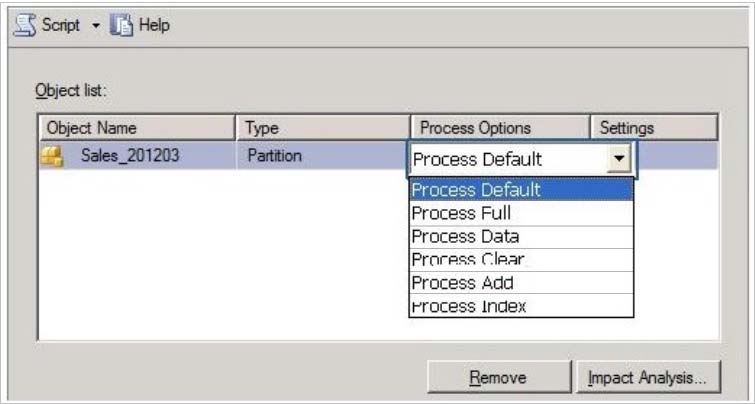
A SQL Server Analysis Services (SSAS) cube contains billions of rows of data and is rapidly increasing in size. The cube consists of a single measure group and a single partition. The cube is currently processed by using the Process Full process option.
You have the following requirements to reduce the cube processing time:
✑ Partition the measure group by month.
✑ Create a staging table that contains only data which is more recent than the last time the cube was processed.
✑ Do not include data updates or deletions in the staging table.
✑ Insert records from the staging table into the appropriate partition.
You need to change the process option to meet the requirements.
Which process option should you choose?
To answer, select the appropriate option from the drop-down list in the dialog box.
Hot Area:

Correct Answer:
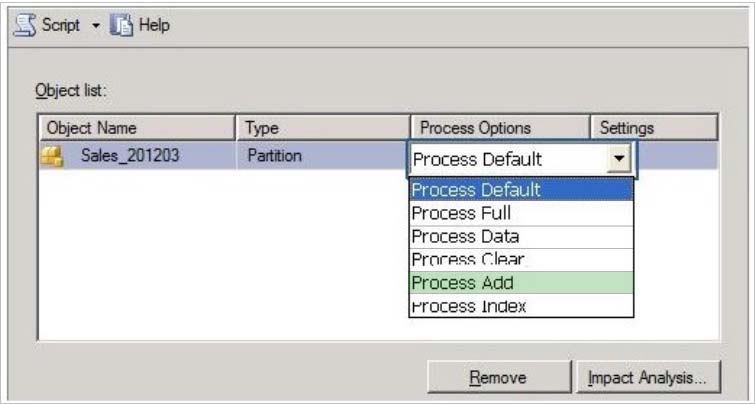
Note:
ProcessAdd -
ProcessAdd applies only to dimensions and partitions.
ProcessAdd is a new processing option for dimensions that did not exist in Analysis Services 2000. It essentially optimizes ProcessUpdate for the scenario where only new members are added. ProcessAdd never deletes or updates existing members. It only adds new members. The user can restrict the dimension table so that ProcessAdd reads only the new rows.
ProcessAdd for partitions is the equivalent of incremental partition processing in Analysis Services 2000. The user typically specifies an alternate fact table or a filter condition pointing to the new rows. ProcessAdd internally creates a temporary partition, processes it with the specified fact data, and merges it into the target partition.
Reference: Analysis Services 2005 Processing Architecture

Note:
ProcessAdd -
ProcessAdd applies only to dimensions and partitions.
ProcessAdd is a new processing option for dimensions that did not exist in Analysis Services 2000. It essentially optimizes ProcessUpdate for the scenario where only new members are added. ProcessAdd never deletes or updates existing members. It only adds new members. The user can restrict the dimension table so that ProcessAdd reads only the new rows.
ProcessAdd for partitions is the equivalent of incremental partition processing in Analysis Services 2000. The user typically specifies an alternate fact table or a filter condition pointing to the new rows. ProcessAdd internally creates a temporary partition, processes it with the specified fact data, and merges it into the target partition.
Reference: Analysis Services 2005 Processing Architecture
send
light_mode
delete
Question #14
DRAG DROP -
You administer a SQL Server Analysis Services (SSAS) instance.
You need to capture a continuous log of detailed event and subevent durations and custom trace events from queries executed in the SSAS instance.
Which three actions should you perform in sequence? (To answer, move the appropriate actions from the list of actions to the answer area and arrange them in the correct order.)
Select and Place:

You administer a SQL Server Analysis Services (SSAS) instance.
You need to capture a continuous log of detailed event and subevent durations and custom trace events from queries executed in the SSAS instance.
Which three actions should you perform in sequence? (To answer, move the appropriate actions from the list of actions to the answer area and arrange them in the correct order.)
Select and Place:

Correct Answer:

Note:
* Auditing an instance of SQL Server or a SQL Server database involves tracking and logging events that occur on the system. The SQL Server Audit object collects a single instance of server- or database-level actions and groups of actions to monitor. The audit is at the SQL Server instance level. You can have multiple audits per SQL Server instance. The Server Audit Specification object belongs to an audit. You can create one server audit specification per audit, because both are created at the SQL Server instance scope.
* Trace events can be started and captured using SQL Server Profiler, , or can be started from an XMLA command as SQL Server Extended Events and later analyzed.
* Extended Event tracing is enabled using a similar XMLA create object script.
Reference: Analysis Services Trace Events

Note:
* Auditing an instance of SQL Server or a SQL Server database involves tracking and logging events that occur on the system. The SQL Server Audit object collects a single instance of server- or database-level actions and groups of actions to monitor. The audit is at the SQL Server instance level. You can have multiple audits per SQL Server instance. The Server Audit Specification object belongs to an audit. You can create one server audit specification per audit, because both are created at the SQL Server instance scope.
* Trace events can be started and captured using SQL Server Profiler, , or can be started from an XMLA command as SQL Server Extended Events and later analyzed.
* Extended Event tracing is enabled using a similar XMLA create object script.
Reference: Analysis Services Trace Events
send
light_mode
delete
Question #15
DRAG DROP -
You plan to deploy a SQL Server Integration Services (SSIS) project by using the project deployment model.
You need to monitor control flow tasks to determine whether any of them are running longer than usual.
Which three actions should you perform in sequence? (To answer, move the appropriate actions from the list of actions to the answer area and arrange them in the correct order.)
Select and Place:
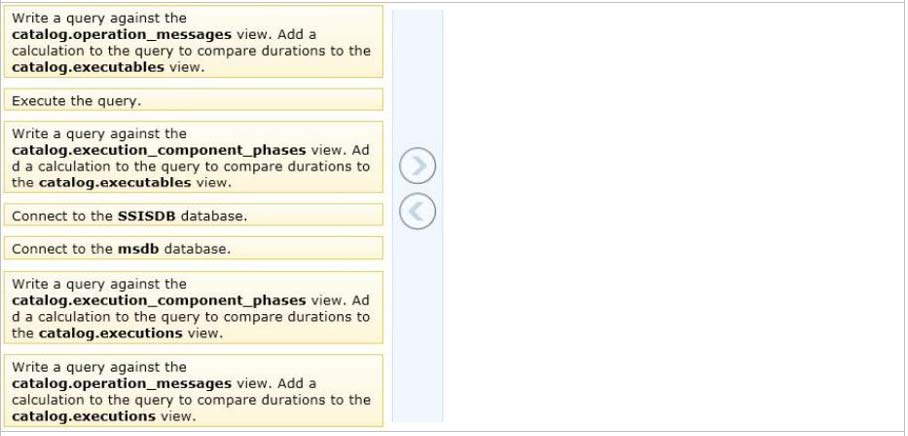
You plan to deploy a SQL Server Integration Services (SSIS) project by using the project deployment model.
You need to monitor control flow tasks to determine whether any of them are running longer than usual.
Which three actions should you perform in sequence? (To answer, move the appropriate actions from the list of actions to the answer area and arrange them in the correct order.)
Select and Place:

Correct Answer:
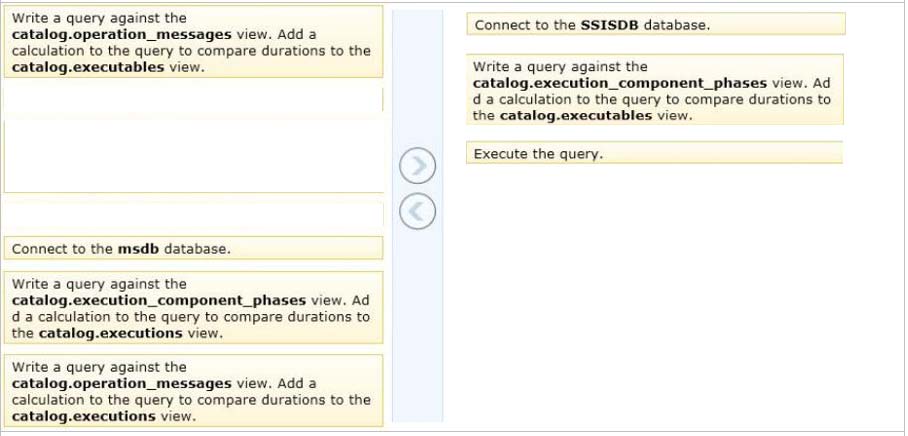
Note:
* execution_component_phases
Displays the time spent by a data flow component in each execution phase.
* The following example uses the catalog.execution_component_phases view to find the total amount of time that a specific package has spent executing in all phases (active_time), and the total elapsed time for the package (total_time). use SSISDB select package_name, task_name, subcomponent_name, execution_path,
SUM(DATEDIFF(ms,start_time,end_time)) as active_time,
DATEDIFF(ms,min(start_time), max(end_time)) as total_time
from catalog.execution_component_phases
where execution_id = 1841
group by package_name, task_name, subcomponent_name, execution_path order by package_name, task_name, subcomponent_name, execution_path
* catalog.executables
This view displays a row for each executable in the specified execution.
An executable is a task or container that you add to the control flow of a package.
*(incorrect) catalog.executions (SSISDB Database)
Displays the instances of package execution in the Integration Services catalog. Packages that are executed with the Execute Package task run in the same instance of execution as the parent package.
This view displays a row for each instance of execution in the catalog.
* (incorrect) catalog.operation_messages
Displays messages that are logged during operations in the Integration Services catalog.
This view displays a row for each message that is logged during an operation in the catalog. The message can be generated by the server, by the package execution process, or by the execution engine.
Reference: catalog.execution_component_phases
Reference: catalog.executables

Note:
* execution_component_phases
Displays the time spent by a data flow component in each execution phase.
* The following example uses the catalog.execution_component_phases view to find the total amount of time that a specific package has spent executing in all phases (active_time), and the total elapsed time for the package (total_time). use SSISDB select package_name, task_name, subcomponent_name, execution_path,
SUM(DATEDIFF(ms,start_time,end_time)) as active_time,
DATEDIFF(ms,min(start_time), max(end_time)) as total_time
from catalog.execution_component_phases
where execution_id = 1841
group by package_name, task_name, subcomponent_name, execution_path order by package_name, task_name, subcomponent_name, execution_path
* catalog.executables
This view displays a row for each executable in the specified execution.
An executable is a task or container that you add to the control flow of a package.
*(incorrect) catalog.executions (SSISDB Database)
Displays the instances of package execution in the Integration Services catalog. Packages that are executed with the Execute Package task run in the same instance of execution as the parent package.
This view displays a row for each instance of execution in the catalog.
* (incorrect) catalog.operation_messages
Displays messages that are logged during operations in the Integration Services catalog.
This view displays a row for each message that is logged during an operation in the catalog. The message can be generated by the server, by the package execution process, or by the execution engine.
Reference: catalog.execution_component_phases
Reference: catalog.executables
send
light_mode
delete
All Pages
